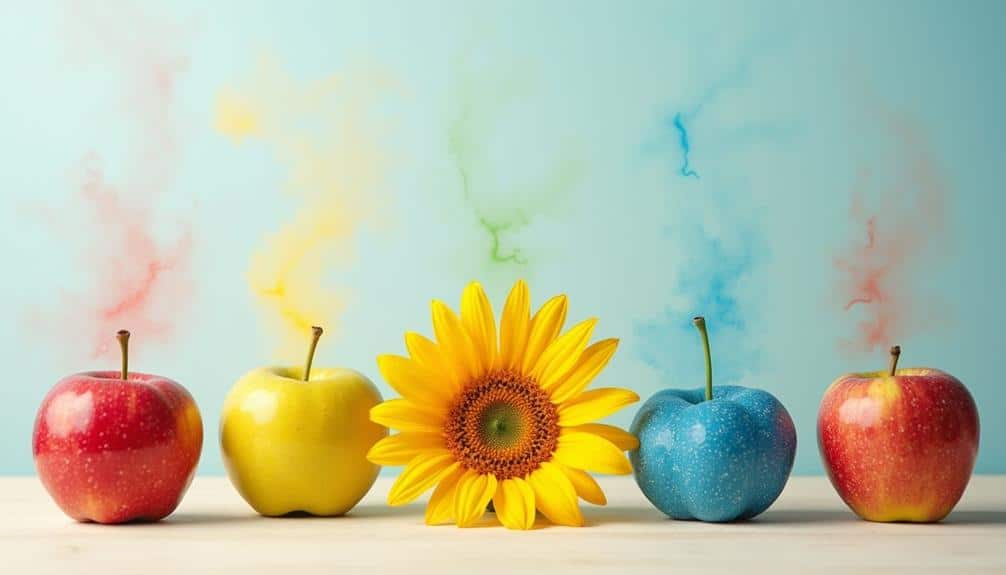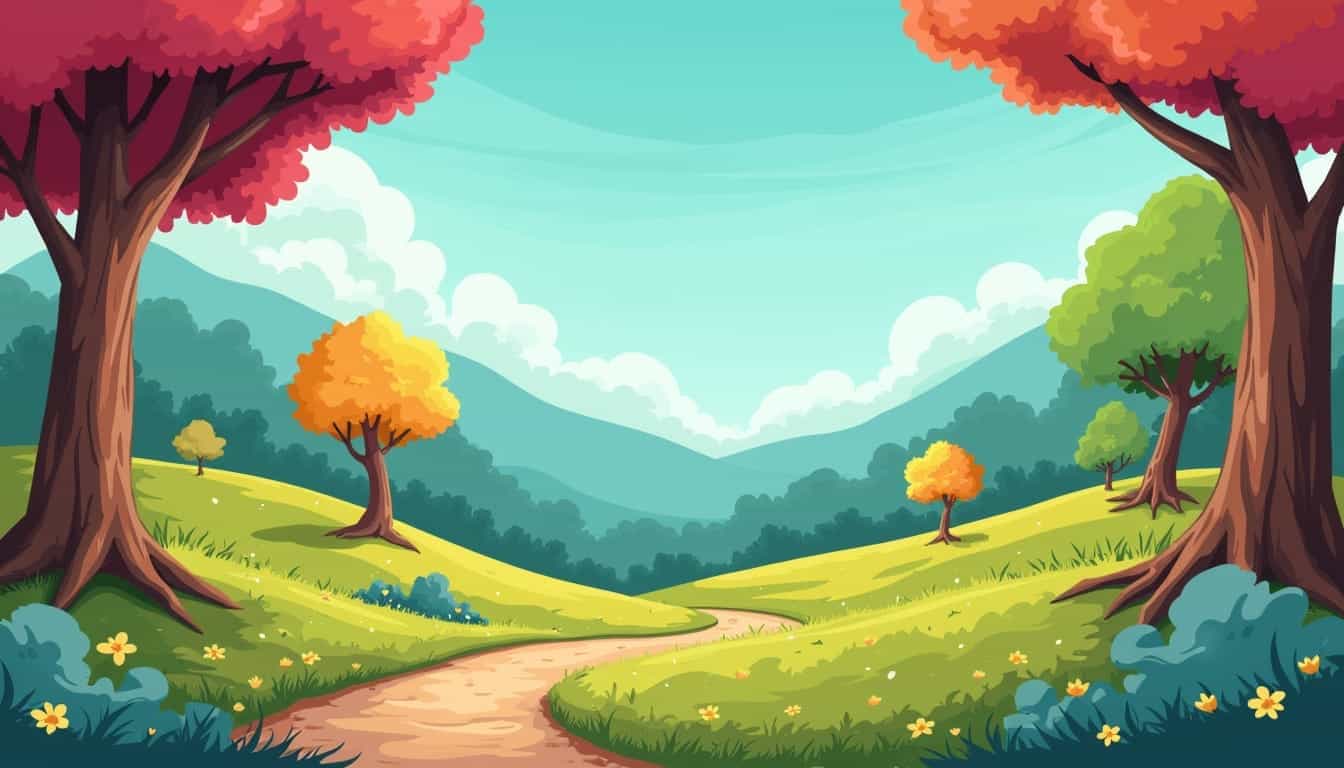Mastering colors and adjectives in Russian is essential for effective communication and cultural insight. Key colors include красный (red), синий (blue), зелёный (green), and жёлтый (yellow). These colors carry significant cultural symbolism, enriching both language and interpreting Russian literature and art. Common adjectives such as большой (big) and маленький (small) enhance descriptive capacity, with gender and number agreement being essential. For instance, “a beautiful red car” translates to красивая красная машина. Utilizing colors and adjectives in practical contexts improves conversational ability and narrative fluency. Exploring further will offer a deeper understanding of their extensive application.
Introduction to Colors in Russian

Understanding colors and adjectives is essential for mastering the Russian language, as they serve as fundamental building blocks for effective communication.
Basic colors like красный (krasnyy) for red and синий (siniy) for blue enable learners to describe their surroundings vividly.
This section will examine the significance of these elements and provide examples to illustrate their practical application in everyday conversations.
Importance of Colors, Adjectives in Russian
In the study of the Russian language, the acquisition of vocabulary related to colors and adjectives serves as a crucial foundation for effective communication. Colors in Russian carry profound cultural significance and are imbued with emotional associations, making them essential for both linguistic and cultural fluency. For instance, the color red (красный, krasnyy) symbolizes beauty and liveliness, while blue (синий, siniy) often represents tranquility and depth.
Understanding these color symbolism nuances aids in the interpretation of literature, art, and everyday interactions.
The practical applications of mastering colors and adjectives are manifold. They enable learners to describe objects, people, and environments more vividly, thereby enhancing their expressive capabilities. Combining colors with adjectives, such as in the phrase Красная машина (Krasnaya mashina, “a red car”), facilitates the creation of detailed and meaningful narratives.
Furthermore, visual learning strategies can greatly benefit from the integration of colors and adjectives, making the language acquisition process more engaging and effective.
Basic Colors in Russian
Mastering the basic colors in Russian serves as an essential step for language learners at the A1 level, enriching their descriptive vocabulary and enhancing their communicative abilities. Understanding the nuances of colors such as красный (krasnyy) for red, синий (siniy) for blue, зелёный (zelyonyy) for green, and жёлтый (zheltyy) for yellow is essential.
These colors are more than mere descriptors; they embody color symbolism deeply entrenched in Russian culture. For instance, красный (krasnyy) not only denotes the color red but also symbolizes beauty and importance, as seen in Красная площадь (Krasnaya ploshchad) or Red Square.
The concept of color mixing is equally important, helping learners understand how primary and secondary colors interact. For example, mixing синий (siniy) and жёлтый (zheltyy) yields зелёный (zelyonyy).
Color perception in Russian also extends into idiomatic expressions, such as “синий чулок” (siniy chulok) meaning a blue stocking, referring to an intellectual woman.
These associations enrich the learning experience, allowing students to grasp both linguistic and cultural dimensions simultaneously. Therefore, acquiring basic color vocabulary is fundamental for a holistic understanding of the Russian language.
Common Adjectives in Russian
Among the foundational elements of the Russian language, common adjectives play a vital role in enabling learners to construct more descriptive and versatile sentences. Adjectives in context provide essential nuances, allowing speakers to convey precise meanings. For instance, common adjective pairs such as “большой и маленький” (big and small) or “красивый и уродливый” (beautiful and ugly) facilitate a richer expression of thoughts.
Understanding adjective placement is essential, as adjectives typically precede the nouns they modify, e.g., “большой дом” (big house). Additionally, utilizing comparative adjectives like “больше” (bigger) and “меньше” (smaller) enriches conversational dynamics, enabling comparisons and contrasts.
Descriptive writing exercises are invaluable for mastering these concepts. By incorporating common adjectives into varied sentences, learners can practice proper adjective placement and hone their skills in creating vivid descriptions. For example, transforming a simple sentence from “дом” (house) to “красивый дом” (beautiful house) enhances its descriptiveness.
In essence, a thorough grasp of common adjectives in Russian not only bolsters linguistic proficiency but also empowers learners to engage in more dynamic and expressive communication.
Using Colors with Adjectives
In combining colors with adjectives in Russian, it is essential to understand the agreement rules in gender and number.
For example, the phrase “a beautiful red car” translates to красивая красная машина (krasivaya krasnaya mashina), where both the color and adjective agree with the feminine noun машина (mashina).
This section will provide examples and guidelines for forming simple phrases, highlighting the importance of grammatical concord in effective communication.
Forming Simple Phrases
To effectively communicate in Russian, forming simple phrases that combine colors with adjectives is essential. The placement of adjectives before nouns is a fundamental rule, as seen in phrases like “Синяя книга” (Sinyaya kniga) meaning “blue book.” Understanding color symbolism and cultural color meanings enriches one’s linguistic repertoire. For instance, красный (krasnyy) for red symbolizes beauty and celebration, while белый (belyy) for white signifies purity.
Color idioms, such as “белая зависть” (belaya zavist’) meaning “white envy,” illustrate the profound integration of color into Russian expressions. Engaging in color-related games can further solidify these concepts, making learning interactive and enjoyable. For example, a game where participants describe objects using colors and adjectives can reinforce proper adjective placement and usage.
Practical examples like “Зеленое яблоко” (Zelyonoe yabloko) for “green apple” or “Желтый цветок” (Zheltyy tsvetok) for “yellow flower” demonstrate simple yet effective communication. By mastering these combinations, learners not only enhance their descriptive abilities but also gain deeper insights into the rich tapestry of Russian culture.
This foundational knowledge serves as a stepping stone toward more advanced linguistic proficiency.
Proper Use of Gender and Quantities
Understanding the agreement in gender and number is crucial when using colors with adjectives in Russian. This intricate aspect of the language demands that both colors and adjectives conform to the gender of the nouns they modify. For instance, the word for red, красный (krasnyy), must be altered to красная (krasnaya) when describing a feminine noun like машина (mashina) and to красное (krasnoye) for a neuter noun like яблоко (yabloko).
Additionally, plural forms necessitate further adjustments. Colors and adjectives adopt the plural endings –ые or –ие, consequently красные машины (krasnye mashiny) translates to “red cars.” Gender agreement extends to plural forms, making comprehension of these variations imperative.
Adjective placement typically precedes the noun, enhancing the descriptive clarity of phrases. However, certain gender exceptions occur, particularly with borrowed or invariable adjectives, necessitating special attention.
These nuances not only enrich linguistic precision but also facilitate more dynamic and culturally resonant communication.
Everyday Vocabulary with Colors

Incorporating colors into everyday vocabulary is essential for practical communication in Russian.
Common objects, such as зелёный стол (zelenyy stol) for “green table” and чёрная кошка (chyornaya koshka) for “black cat,” provide foundational examples.
Practicing phrases like Белый дом (Belyy dom) for “white house” can greatly enhance one’s proficiency and confidence in using colors contextually.
Objects and Their Colors
When starting on the process of learning Russian, the ability to identify and describe objects using colors is an important skill. Mastering this aspect of the language not only broadens one’s vocabulary but also provides insights into Russian color symbolism and cultural significance.
For instance, a красная машина (krasnaya mashina) or “red car” might evoke passionate or patriotic associations, considering red’s historical and cultural resonance in Russia.
Understanding color perception and its linguistic applications can enhance learners’ grasp of nuanced meanings. A зелёное яблоко (zelyonoye yabloko) or “green apple” uses the color green, which in Russian often symbolizes youth and energy.
Meanwhile, a белая рубашка (belaya rubashka) or “white shirt” could imply purity or formality, reflecting common cultural associations with the color white.
Effective communication in Russian involves recognizing appropriate color combinations, such as describing a голубое небо (goluboye nebo) or “blue sky” versus a серое небо (seroye nebo) or “gray sky,” each conjuring different emotional landscapes.
Common Phrases to Practice
Mastering everyday vocabulary with colors in Russian opens the door to more effective and nuanced communication. The integration of colors and adjectives not only enriches descriptive language but also imbues it with cultural references and color symbolism.
Common phrases to practice include желтое солнце (zheltoye solntse) for “yellow sun” and зеленая трава (zelenaya trava) for “green grass.” These phrases highlight the color associations prevalent in Russian culture, enriching one’s expressive language capabilities.
Understanding adjective usage is essential. For instance, большой (bol’shoy) combined with синий (siniy), as in большой синий дом (bol’shoy siniy dom) for “big blue house,” demonstrates the importance of gender agreement and adjective placement.
Delving into color associations, красный (krasnyy) evokes powerful cultural symbolism, often linked to beauty and strength, as in красная роза (krasnaya roza) for “red rose.”
Through the practice of these phrases, learners can achieve a deeper understanding of Russian culture and language, paving the way for more sophisticated communication and innovative linguistic expression.




